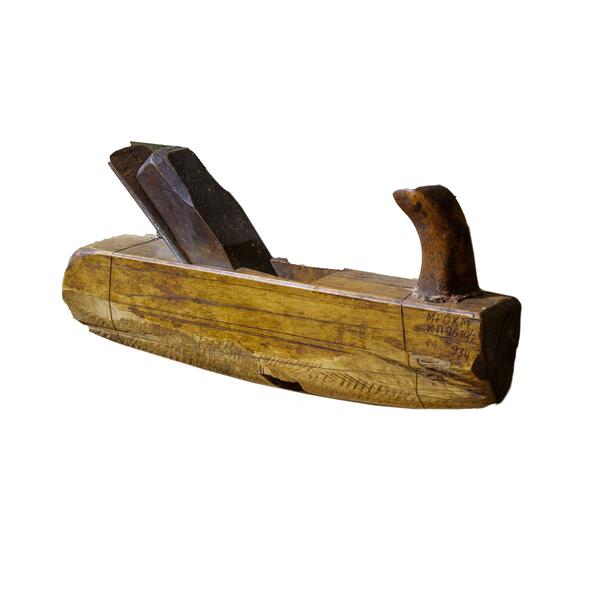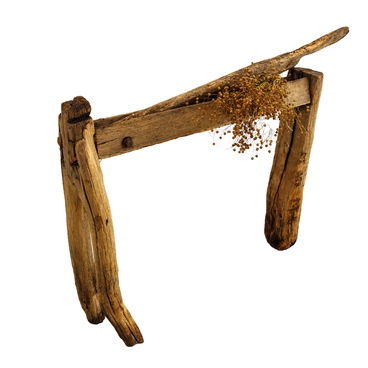This cooper’s plane belonged to a carpenter, a resident of the village of Levzhi, Ruzaevsky district, the Republic of Mordovia. His name has not been preserved. This tool is also called “gorbach” (circle plane).
The plane consists of a block, the sole of which is rounded to the longitudinal edges and raised to the end edges, a front stop handle and a through slot in the block, into which a rounded cutter, fixed with a wedge is inserted. For planing the outside of the staves — the boards that make up the walls of the cooper-ware — people used a conventional plane with a straight knife and a flat sole. And a circle plane was needed for processing concave surfaces: for example, the inside of the barrel staves along the edge, where the bottom was supposed to be embedded. Therefore, its sole is curved.
On the territory of the Mordovian Region, cooperage began to emerge in the second half of the 17th century. Potash (a type of salt), resin and tar were produced in large quantities here. Barrels, tubs and other woodenware were needed to store them.
The cooper was considered a highly skilled craftsman. In the village of Pichkiryaevsky Maidan, the cooper was paid 6 rubles, 10 quarters of rye, 3.5 quarters of oats and 3 poods of salt per year in the 18th century. A quarter was about 60 kilograms, and a pood was 16 kilos. The cooper had to make 120 barrels, and also, if necessary, make buckets, kneading troughs, tubs and watering cans for this fee.
Potash production on the territory of the region did not last long, but the cooperage craft flourished: woodenware was in demand among citizens. According to the All-Russian Population Census of 1897, 1,786 people were engaged in cooperage on the territory of the Mordovian territory. At the turn of the 19th–20th centuries, cooperage was especially developed in Saransk and Krasnoslobodsky counties. Half of all Krasnoslobodsk coopers lived in the Russian village of Zheltonogovo, where large and small barrels, kegs, tubs were made since ancient times. For these dishes masters most often chose solid oak, aspen, pine, and spruce wood. timber by single trees, in wagons, or by whole plots — plots allocated for woodcutting. Oak billets were used for containers where people stored fish, honey, oil, while butter, resin, and tar were stored in products made of linden, pine and spruce.
The material was usually harvested in June, to allow the staves to dry well. Masters worked in spring and summer in the sheds, and in winter and autumn — inside their homes. Only few masters had special workshops.
The plane consists of a block, the sole of which is rounded to the longitudinal edges and raised to the end edges, a front stop handle and a through slot in the block, into which a rounded cutter, fixed with a wedge is inserted. For planing the outside of the staves — the boards that make up the walls of the cooper-ware — people used a conventional plane with a straight knife and a flat sole. And a circle plane was needed for processing concave surfaces: for example, the inside of the barrel staves along the edge, where the bottom was supposed to be embedded. Therefore, its sole is curved.
On the territory of the Mordovian Region, cooperage began to emerge in the second half of the 17th century. Potash (a type of salt), resin and tar were produced in large quantities here. Barrels, tubs and other woodenware were needed to store them.
The cooper was considered a highly skilled craftsman. In the village of Pichkiryaevsky Maidan, the cooper was paid 6 rubles, 10 quarters of rye, 3.5 quarters of oats and 3 poods of salt per year in the 18th century. A quarter was about 60 kilograms, and a pood was 16 kilos. The cooper had to make 120 barrels, and also, if necessary, make buckets, kneading troughs, tubs and watering cans for this fee.
Potash production on the territory of the region did not last long, but the cooperage craft flourished: woodenware was in demand among citizens. According to the All-Russian Population Census of 1897, 1,786 people were engaged in cooperage on the territory of the Mordovian territory. At the turn of the 19th–20th centuries, cooperage was especially developed in Saransk and Krasnoslobodsky counties. Half of all Krasnoslobodsk coopers lived in the Russian village of Zheltonogovo, where large and small barrels, kegs, tubs were made since ancient times. For these dishes masters most often chose solid oak, aspen, pine, and spruce wood. timber by single trees, in wagons, or by whole plots — plots allocated for woodcutting. Oak billets were used for containers where people stored fish, honey, oil, while butter, resin, and tar were stored in products made of linden, pine and spruce.
The material was usually harvested in June, to allow the staves to dry well. Masters worked in spring and summer in the sheds, and in winter and autumn — inside their homes. Only few masters had special workshops.



